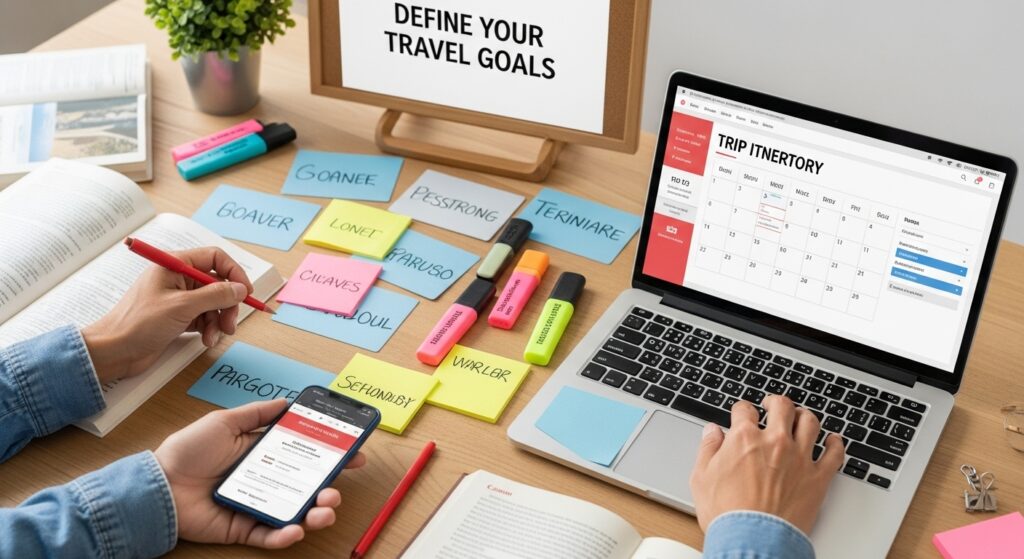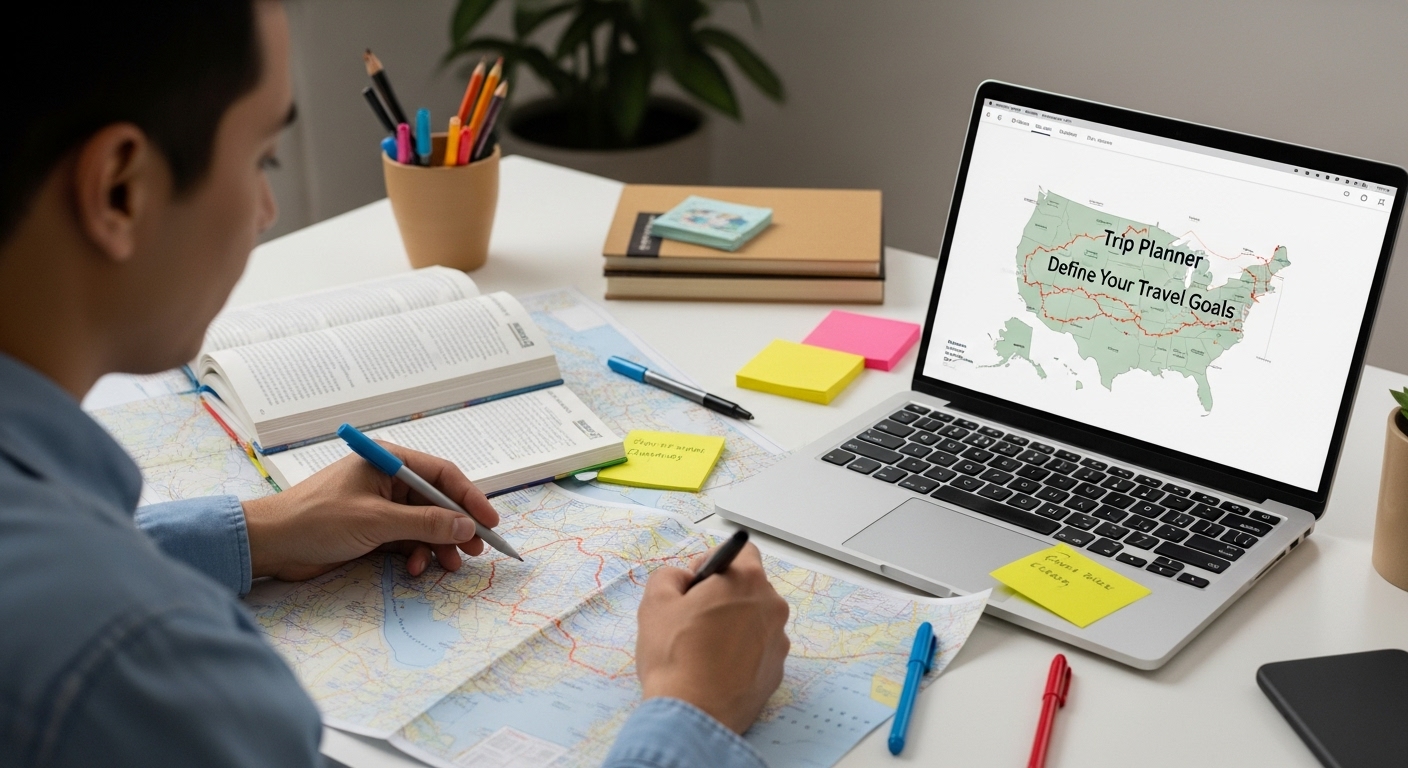Planning a trip usually sounds simple. Pick a place, pick some dates, and pack your bags, right? Not so fast. Over 65 percent of travelers report that poorly organized itineraries led to missed opportunities and unexpected hassles, even when the destination was perfect. The real magic of travel happens before you ever leave home, and it all starts with a few smart steps most people skip.
Table of Contents
- Step 1: Define Your Travel Goals And Preferences
- Step 2: Research Your Destination And Activities
- Step 3: Organize Your Travel Dates And Logistics
- Step 4: Create A Daily Schedule With Flexibility
- Step 5: Review And Adjust Your Itinerary Based On Feedback
- Step 6: Finalize And Share Your Itinerary
Quick Summary
| Key Point | Explanation |
|---|---|
| 1. Define your travel goals clearly | Understand whether you seek relaxation, adventure, or cultural immersion to guide your trip planning decisions. |
| 2. Conduct thorough destination research | Gather detailed information from multiple sources for a richer, more meaningful travel experience and to avoid common tourist traps. |
| 3. Organize travel logistics meticulously | Create a detailed timeline, book transportation early, and select accommodations that fit your needs to minimize stress. |
| 4. Create a flexible daily schedule | Balance must-do activities with unstructured time to accommodate spontaneous adventures without feeling overwhelmed. |
| 5. Review your itinerary for feedback | Seek insights from others to identify blind spots and enhance your travel plans based on real experiences and practical advice. |
Step 1: Define Your Travel Goals and Preferences
Successful trip planning starts with understanding exactly what you want from your journey. Defining your travel goals and preferences is the critical foundation that transforms a generic vacation into a personalized adventure tailored precisely to your interests and needs. Clarity about your travel objectives will guide every subsequent decision in your itinerary creation process.
Begin by conducting an honest self-assessment of what truly excites you about traveling. Are you seeking relaxation, cultural immersion, adventure, personal growth, or a blend of experiences? Consider the activities that energize you: do you love exploring historical sites, enjoying culinary experiences, hiking through natural landscapes, or lounging on pristine beaches? Your travel style and personal preferences will significantly shape the entire trip blueprint.
To crystallize your goals, create a detailed profile of your ideal travel experience. This involves examining multiple dimensions beyond just destination selection. Think about your preferred pace of travel – do you enjoy packed, activity-driven days or more leisurely, spontaneous exploration? Consider your comfort levels with different types of accommodations, transportation methods, and social interactions. Some travelers prefer structured group tours, while others thrive on independent wandering.
Consider practical constraints that will influence your planning, such as available vacation time, budget limitations, physical fitness levels, and personal interests. A comprehensive understanding of these factors ensures you design an itinerary that feels authentic and achievable. Check out our comprehensive trip planning guide for additional insights into crafting the perfect travel experience.
The Centers for Disease Control and Prevention recommends documenting your travel objectives and personal requirements as a strategic first step. By clearly articulating what you want from your trip, you create a powerful roadmap that transforms abstract dreams into concrete travel plans. Your goal is to develop a crystal-clear vision that will guide every subsequent decision in your itinerary creation process.
Step 2: Research Your Destination and Activities
Researching your destination thoroughly transforms a generic trip into an extraordinary adventure.
This critical step moves you beyond surface-level tourism, diving deep into the unique characteristics that make your chosen location special. Comprehensive destination research provides the foundation for creating an authentic, meaningful travel experience that goes far beyond typical tourist attractions.
Start by gathering information from multiple sources to build a multifaceted understanding of your destination. Official tourism websites, travel blogs, guidebooks, and social media platforms offer different perspectives that can help you uncover hidden gems and understand local nuances. Pay attention to seasonal considerations, local festivals, cultural events, and specific details that might impact your travel experience. Consider watching travel documentaries, reading books set in the destination, and connecting with travelers who have recently visited the area to gain firsthand insights.
Develop a strategic approach to exploring potential activities by categorizing them based on your personal interests and travel goals. Research attractions that align with your preferences, whether they involve historical sites, outdoor adventures, culinary experiences, or cultural interactions. Look beyond standard tourist routes and investigate unique local experiences that offer genuine connections with the destination. Explore our comprehensive trip planning resources to help refine your activity selection process.
Technology can be an incredible ally in destination research. Utilize travel forums, interactive maps, virtual tours, and destination-specific apps to gather detailed information. The U.S. Department of State recommends thorough destination research as a crucial safety and preparation step. Take time to understand local customs, transportation systems, potential language barriers, and any travel advisories that might impact your plans. By investing effort in comprehensive research, you create a robust foundation for an incredible, well-informed travel experience that minimizes surprises and maximizes enjoyment.
Step 3: Organize Your Travel Dates and Logistics
Organizing travel dates and logistics transforms your trip from a vague concept into a concrete plan. This critical step requires meticulous attention to detail and strategic planning that considers every aspect of your journey. Successful logistics management ensures smooth transitions and minimizes potential travel stress, allowing you to focus on enjoying your adventure.
Begin by establishing a realistic timeline that accounts for travel duration, work commitments, seasonal considerations, and personal constraints. Examine potential travel windows that offer optimal weather conditions, affordable pricing, and alignment with your personal schedule. Consider flexibility in your dates, understanding that shoulder seasons often provide better experiences with fewer crowds and more competitive pricing. Factor in buffer days for unexpected delays or spontaneous experiences, creating breathing room in your itinerary that prevents overwhelming scheduling.
Transportation and accommodation represent the core structural elements of your travel logistics. Research and book flights, train tickets, or other primary transportation methods well in advance, comparing prices and examining routing options that maximize convenience and minimize travel fatigue. When selecting accommodations, consider proximity to key attractions, local transportation accessibility, and amenities that match your travel style. Look beyond standard hotel options and explore diverse lodging possibilities such as vacation rentals, boutique hotels, or unique local stays that enhance your travel experience.
Check out our comprehensive trip planning guide for additional strategies in managing complex travel logistics. The U.S. Department of State recommends creating a detailed travel document that includes copies of critical information like passport details, emergency contacts, and travel insurance. Verify your planning by ensuring you have a centralized digital or physical folder containing all essential travel documents, reservation confirmations, and backup contact information. By methodically organizing these critical logistics, you create a robust framework that supports a seamless, stress-free travel experience.

Step 4: Create a Daily Schedule with Flexibility
Creating a daily travel schedule that balances structure and spontaneity is an art form that transforms a good trip into an exceptional experience. Effective itinerary planning requires a strategic approach that provides guidance without feeling restrictive, allowing room for unexpected discoveries and personal whims. Your goal is to design a framework that supports your travel objectives while remaining adaptable to real-world travel dynamics.
Begin by prioritizing your must-do activities and anchor them as centerpiece experiences in your daily schedule. These core activities should receive dedicated time slots, considering factors like opening hours, required travel time, and potential wait times. Group complementary activities geographically to minimize unnecessary travel and maximize efficiency. Consider the natural rhythm of your destination – some cities have specific times when attractions are most enjoyable or less crowded. Factor in realistic transition times between locations, understanding that travel always takes longer than anticipated, especially in unfamiliar environments.
Design your schedule with intentional flexibility by incorporating buffer periods and unscheduled time blocks. These open windows allow for spontaneous exploration, unexpected opportunities, rest, or recovery from travel fatigue. Allocate approximately 20-30% of your daily schedule as unstructured time, which provides breathing room for serendipitous experiences. Technology can be an incredible ally in maintaining this delicate balance. Digital tools and apps offer real-time updates, alternative activity suggestions, and the ability to quickly adjust plans. Explore our comprehensive trip planning resources to discover innovative scheduling strategies.
The gTravel research system emphasizes the importance of creating intelligent, adaptive travel paths that accommodate unexpected changes. Verify your schedule’s effectiveness by ensuring it meets three key criteria: your primary travel goals are addressed, you have built-in flexibility, and the pace feels comfortable and exciting rather than overwhelming. By crafting a thoughtful, dynamic daily schedule, you create a travel blueprint that guides without constraining, inviting both planned experiences and spontaneous adventures.
Step 5: Review and Adjust Your Itinerary Based on Feedback
Reviewing and adjusting your travel itinerary is a critical final step that transforms a generic plan into a personalized, optimized travel experience. This process transforms your initial draft into a refined, thoughtful blueprint that accounts for diverse perspectives and practical considerations. Feedback serves as a powerful tool for identifying potential blind spots, uncovering hidden opportunities, and stress-testing the feasibility of your travel plans.
Seek input from multiple sources to gain comprehensive insights into your proposed itinerary. Reach out to travelers who have recently visited your destination, consult local travel forums, and engage with friends or family members who have experience with similar trips. Pay special attention to practical advice about transportation logistics, recommended time allocations for attractions, potential cultural nuances, and realistic travel times between locations. Be open to constructive criticism and view each piece of feedback as an opportunity to enhance your travel experience. Some suggestions might challenge your initial assumptions, but they often reveal valuable perspectives you might have overlooked.
Technology and digital platforms can significantly streamline the feedback and refinement process. Explore our comprehensive trip planning resources to discover innovative ways of gathering and integrating travel insights. Digital tools allow you to quickly compare recommendations, cross-reference advice, and make rapid adjustments to your itinerary. Develop a systematic approach to evaluating feedback by creating a prioritization matrix that helps you distinguish between essential modifications and optional suggestions. Consider factors like feasibility, potential impact on your overall travel experience, and alignment with your original travel goals when deciding which recommendations to incorporate.
The Design for Education Policy research emphasizes the importance of being receptive to external input while maintaining your core vision. Verify the effectiveness of your refined itinerary by ensuring it meets three critical criteria: it remains true to your original travel objectives, incorporates practical insights from trusted sources, and maintains a sense of excitement and spontaneity. By approaching itinerary refinement as an collaborative, iterative process, you create a travel plan that is both meticulously crafted and wonderfully adaptable.
Step 6: Finalize and Share Your Itinerary
Finalizing and sharing your travel itinerary transforms your carefully crafted plan from a personal document into a collaborative roadmap that ensures smooth communication and preparedness. This critical step bridges individual planning with practical execution, creating a comprehensive reference point that keeps everyone informed and aligned throughout your journey. The art of finalizing an itinerary involves meticulous organization, strategic communication, and thoughtful preparation.
Begin by consolidating all your research, feedback, and adjustments into a single, comprehensive document that provides crystal-clear details about your travel experience. Create a master itinerary that includes essential information such as flight numbers, accommodation addresses, reservation confirmations, activity timings, and emergency contact details. Organize this information chronologically and consider using color-coding or visual separators to enhance readability. Digital tools can be incredibly helpful in this process, allowing you to create shareable, interactive documents that can be easily updated and accessed by travel companions or trusted family members.
Sharing your finalized itinerary requires a strategic approach that balances information transparency with personal privacy. Explore our comprehensive trip planning resources to discover innovative ways of communicating your travel plans. Select specific individuals who should receive your detailed travel information, such as immediate family members, travel companions, or a trusted emergency contact. Consider creating different versions of your itinerary – a detailed one for close contacts and a more general overview for broader sharing. Ensure that your shared documents include critical information like emergency contact numbers, basic medical details, and primary accommodation information while protecting sensitive personal data.
The U.S. Department of Commerce recommends confirming all travel details and spacing critical appointments comfortably. Verify the effectiveness of your finalized itinerary by ensuring it meets three key criteria: all reservations are confirmed, key contacts have been informed, and you have multiple backup copies stored both digitally and physically.
Below is a checklist to help you verify your final travel itinerary covers all essential information for a stress-free trip.
| Verification Step | What to Check |
|---|---|
| Reservations Confirmed | Ensure all flights, accommodations, and activities are booked and details are accurate. |
| Emergency Contacts Shared | Provide itinerary and emergency contact info to trusted individuals. |
| Backup Copies Stored | Save digital and physical copies of your itinerary and key documents. |
| Activity Scheduling Verified | Double-check activity times, durations, and any required reservations. |
| Accommodation Details Included | List addresses, check-in/check-out times, and contact info for all stays. |
| Health & Safety Info Documented | Include important medical details and local emergency numbers. |
| Transportation Logistics Complete | Confirm all tickets, routes, and local transit details are included. |

Transform Your Itinerary Stress into Seamless Planning with Yopki
Struggling to juggle spreadsheets and endless research while building the perfect trip itinerary? This article highlights the frustration of balancing travel dates, personal interests, and logistics. It explains the challenge of keeping plans flexible, keeping all your bookings in one place, and making sure everyone has the latest schedule. These pain points can take the fun out of planning and leave you feeling overwhelmed. If you want to make trip planning simple, visual, and personalized, Yopki was built for travelers like you.

Stop piecing your trip together by hand. With Yopki, you can instantly generate a customized travel schedule, organize your days on a smart map, and adjust every event with drag-and-drop ease. All your confirmations stay in one place and our AI Travel Concierge takes care of the details while you stay focused on experiencing what matters most. Ready to plan your next adventure the easy way? Visit Yopki’s platform to start bringing your travel dreams to life today.
Frequently Asked Questions
What should I consider when defining my travel goals?
Understanding your travel goals includes assessing what excites you about traveling, such as relaxation, adventure, or cultural experiences. Additionally, consider your travel style, preferred pace, budget, and any practical constraints.
How can I effectively research my travel destination?
Start by gathering information from official tourism websites, travel blogs, guidebooks, and social media. Explore seasonal factors, local festivals, and cultural events, and utilize technology like travel forums and destination-specific apps for comprehensive insights.
What key logistics should I organize for my trip?
Organize your travel dates, transportation methods, and accommodations. Create a realistic timeline that factors in weather, pricing, and your personal schedule, and ensure all critical information, such as flight details and reservations, are documented and verified.
How can I create a flexible daily schedule for my trip?
Create a daily schedule that prioritizes must-do activities while incorporating buffer periods for spontaneous exploration. Aim for 20-30% of your schedule to remain unstructured, allowing you to adapt to the flow of the trip and enjoy unexpected moments.



